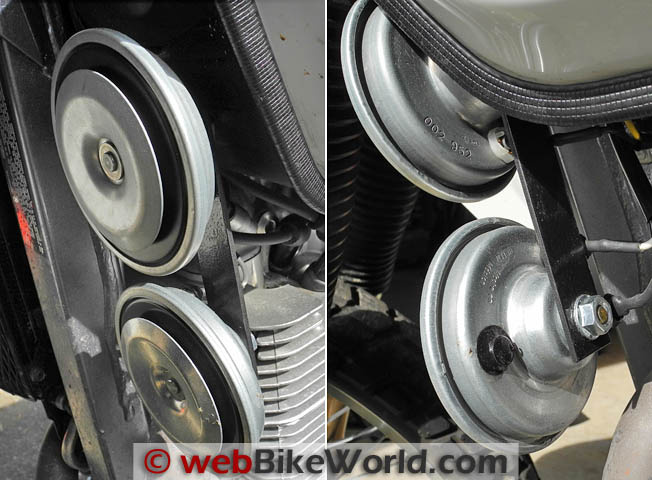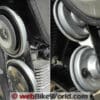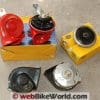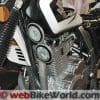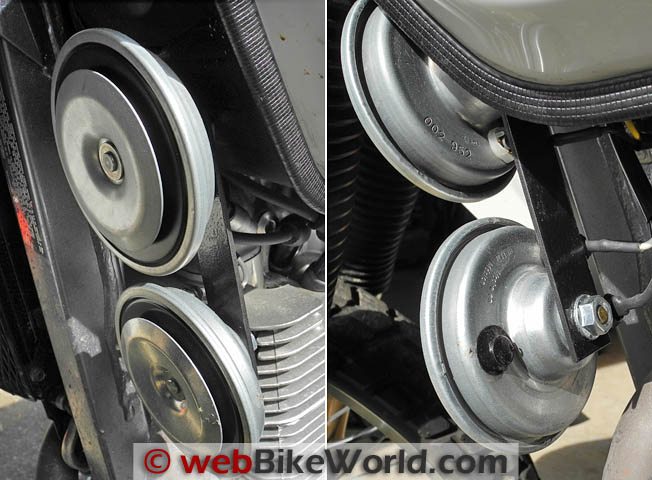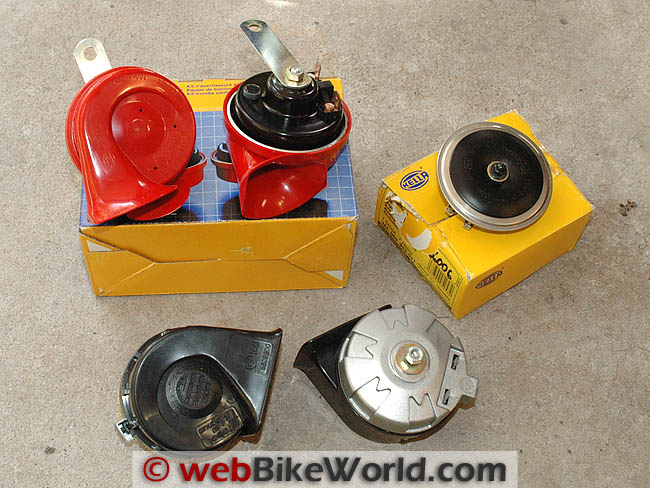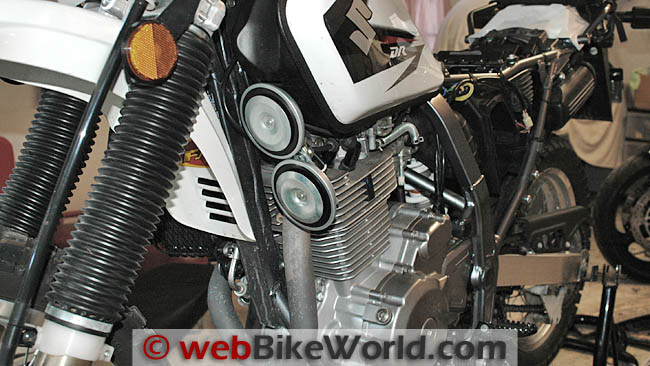Hella does it again with a 115 dB rated disk-type or diaphragm “pancake” horn.
They’re not pretty, but the slim size fits where others won’t.
Pair up the high and low tones for a particularly obnoxious and attention-getting sound.
This didn’t start out as anything like a Part 2 of our 2008 motorcycle horn comparison.
All I wanted to do was improve on the lame “mmeeeep” sound coughed up by the disk-type horn that Suzuki stuck on the DR650.
Fortunately, it wasn’t going to cost much because I discovered some horns left over from the previous horn comparison we did in 2008.
The leftovers included a pair of Hella “pancake” disk or diaphragm horns; the pair of Stebel Magnum horns we used in that review and a pair of red Hella “Twin Tone” trumpet horns that I thought were lost in shipping but here they are, three years later sitting right in the box…
So I had a good selection to choose from for the DR650 and I figured it would be a good time to clear out the inventory and do another quick comparison as a follow-up.
Burn and I were talking it over and looking at the horns when we quickly realized there might be a problem; the DR650 is a pretty lean beast and there really isn’t much space on the bike to shoehorn in a pair of trumpet or bell-type horns.
The stock horn is the typical small pancake (diaphragm) type, hanging on a strip of metal under the left side of the fuel tank, just in back of the forks. There isn’t enough space in that location for a bell or trumpet style horn, or at least not without a lot of fettling. Perhaps some DR650 owners have figured out a better placement for this type of horn?
Also, I wanted a pair of horns for the best effect and if one didn’t fit, two certainly wouldn’t.
The problem is the fender, which barely gives any clearance to the stock horn location as the front wheel swings back and forth when the bars are turned. So if I wanted to hang a pair of horns using the stock mounting bracket, they would have to be about the same thickness as the factory Suzuki horn.
Fortunately, it looked like the pair of Hella pancake horns I had in the box would fit, and the bonus is that they are also the loudest of the bunch.
Hella Disk Type Horn
These are the basic, no-frills Hella disk type horn, rated at 115dB. They have a list price of around $25.00 each but can be found for around $18.00 each in this Hella Horns selection at Amazon.com (affiliate).
Our pair was made in Germany and purchased back in 2008, so I’m not sure if they are identical to the 2011 versions I’ve seen for sale, but they appear to be and they carry the same specs. There are several OE Hella disk horns for sale in 2011, but I don’t know if they all have the same sound volume or tone. These were purchased at Rally Lights (Susquehanna MotorSports).
I recall that one of the reasons I bought these was because they were made in Germany, but you have to look closely at the box when you buy any horn, because what appears to be the exact same horn may be made in India or elsewhere. This goes for most of the brand names.
I can only assume the sound and build quality is the same no matter where they are made (and this does seem to be true, based on our experience). A pair of the Hella pancake horns consists of the low tone, part number HL66010D (335Hz) and the high tone, part number HL66019D (400Hz).
A single Hella disk-type horn can is 90.5 mm wide and it can replace the standard Suzuki DR650 horn to give a louder sound that the stock horn. But if one Hella is good, a pair is even better, louder and more attention-getting. It does take some work to get a pair to fit on this bike, however.
We were not able to fit any of the trumpet-style horns using the stock DR650 horn bracket, although it might be possible to squeeze at least one trumpet-type horn on the bike somewhere with a bit of work. If you’re handy with metal bending and welding, you could fashion a bracket that would utilize the stock mounting location to fit dual trumpets.
In addition to the Hella disk horns I had left over from 2008, I had the pair of Stebel Magnum horns from that review and a pair of red Hella Twin Tone trumpet horns rated at 110 dB (400 Hz and 500 Hz).
The pair of Hella pancake horns came with an extra mounting strip and we first tried to bolt the extra strip on to the existing mount and hang one horn off the top and one off the bottom. But this proved to be too flimsy for the heavier Hella horns, so we bought a strip of 1/4″ thick by 1″ wide metal plate at Lowe’s, the local hardware superstore.
We cut it and drilled one hole for the stock DR650 mount and another hole at the bottom for the second horn. We painted it with some leftover dark gray “Hammertone” spray paint. Then we bolted the horns to the strap using the nuts that came with the kit and Loctite to hold them. Here’s a photo:
We also installed a dual horn relay wiring kit (review) from Eastern Beaver, which includes a pre-wired relay and all the connections and takes a lot of the hassle out of wiring the horns. You’ll need to wire in a relay to power the accessory horns.
We had to shorten the length of the wiring harness because it wasn’t needed on the DR650 and there isn’t much room to stow a coil of wire under the fuel tank, so a pair of Posi-Lock connectors (sale page) came in handy for the task.
The standard Hella disk-type horns are made for under-the-bonnet installation in a car, with only a galvanized surface finish, so they don’t look as nice as the red Hella Supertone horns (review).
I didn’t have a pair of Supertones handy because they were sold with the GT1000, but I think they might be too thick to fit the Suzuki anyway.
I’m not sure how this pair of Hella horns will hold up in the rain, but I never had a problem with the Supertones and these are basically the same but without the red trim ring, so I’m not anticipating a problem.
Also, the water runs right out of the disk-type horn, while it can get trapped inside the bell mouth of a trumpet-type horn.
One other factor to consider is that the disk type horns on the Suzuki DR650 point towards the front, where they will project the most sound. A trumpet-style horn must be mounted with the bell end pointed down to drain any water that enters.
This means that the sound is directed towards the ground or the sides rather than the front.
Sound Recording and the Horn Comparison .mp3 File
We rigged up the Extech sound meter 11 feet away from the front of the Suzuki, which was sitting on the Steel Horse rear stand (review). The bike was near the front of the garage and the Extech meter was outside, placed on a tripod 2 feet above the driveway.
The stock Suzuki horn registered 104.9 dB; not a bad showing at all actually and rather surprising. A single Stebel Magnum registered 98.0 dB and one of the Hella Twin Tone horns sounded off at 100.7 dB.
The pair of Hella pancake horns hit 117.2 dB, higher than the rated 115 dB (each) rating. Here’s the horn comparison .mp3 file (0:1:35) with a comparison of each horn, then all 4 horns at the end.
Conclusion
Installing a pair of Hella disk-type horns is a relatively easy project and definitely improves on the sound of the stock Suzuki diaphragm horn.
One Hella horn can easily replace the stock disk-type horn on most motorcycles and a pair is even better, but you’ll need a relay unless your horn system already uses one.
A diaphragm horn doesn’t have that deep trumpet sound, but a pair of the Hella horns does make a lot of noise and the tone is particularly attention-getting.
One note: I have never used a horn in anger on a motorcycle, so it’s rather ironic that I have installed loud accessory horns on every motorcycle I have owned. I ride defensively and assume I am completely invisible in traffic, so I have not put myself in a position where I need a horn to warn others of my presence.
Publication Date: June 2011
Owner Comments and Feedback
See details on submitting comments.
From “P.H.” (August 2012): “Excellent reviews and feedback. I’m an avid honker on my Concours, which has pretty good stock horns. My new Toyota came with semi-useless meep-meeps, so I replaced ’em immediately with Stebel Magnums TM80s.
They were fairly loud and attention-getting, but died and shorted out after ~6 years. Now have Fiamm Freeway Blasters. They seem to make comparable noise…we’ll see how they hold up.”
From “P” (06/2011): “In my experience, disk horns can often be improved by tweaking the adjusting screw on the back. The screw is sometimes locked in place with a dab of putty but can easily be broken free. Then, by turning the screw incrementally CW and CCW, with test beeps each time, the volume and tone can be changed.
It’s worth noting where the screw was when you started just in case you want to put it back there. This process is painfully loud without good ear protection, and goes a lot faster with a helper. It might be worth the effort.
BTW, horns will sound different depending on their mounting method. Lying loose on a workbench will not give the same sound as mounted on the bike, and the semi-flexible mounting strap that usually comes with the horn makes a difference, too.”
From “T.G.” (06/2011): “I agree, in this day and age why does every motorcycle come with the quietest “meep meep” horn they can find? I have resorted to the Stebel “bad boy” air horn. 120dB of scare the coffee out of the cage driver goodness. It’s even painful to me wearing a full face helmet. It will scare any vehicle back into their own lane as they think they are cutting off a semi-truck.
You can not run it off of the standard horn button, you need to wire in a relay as the horn will draw a full hard 10 amps when honked. you can find them in black to hide well on a modern bike or shiny chrome for the chrome covered cruiser.”
From “B” (06/2011): “Good article. I had a similar quandary to solve, but my end result was a little surprising. After finding out that my buddy’s R1200RT (2005) had a dual-frequency set of horns, one low and one high, I figured out which one was most dissimilar from my stock F800ST horn and added it into the circuit, to effectively create a dual frequency horn. It was inexpensive and highly effective. My bike sounds like a freight train and always catches people’s attention if necessary.”


